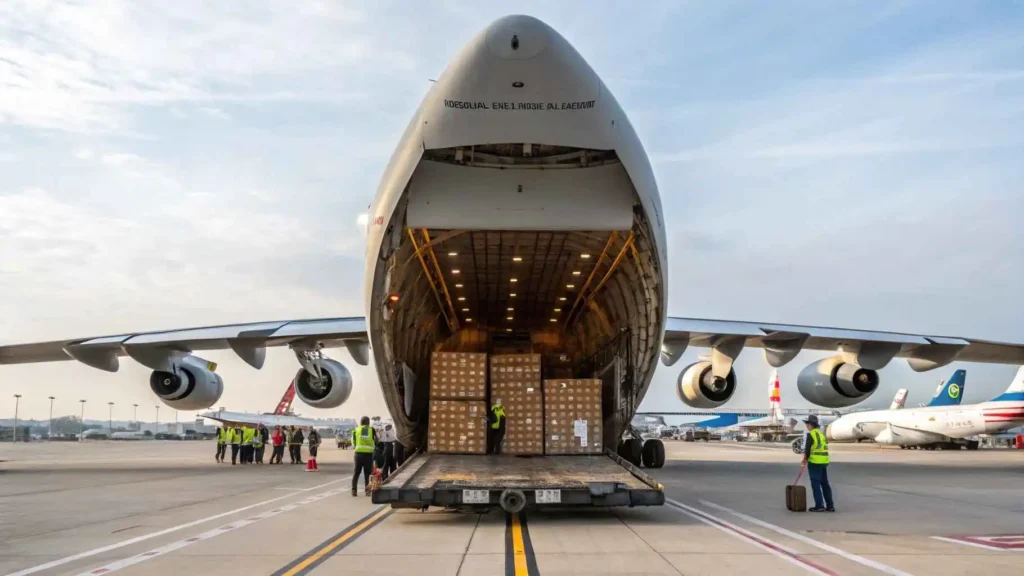Starting a business in Nepal? Here’s the reality check nobody talks about—navigating the cargo service in Nepal’s landscape is like playing chess blindfolded. But don’t worry, we’ve been in the trenches, and we’re breaking down exactly what you’re up against.
Nepal Logistics Challenges: How Being Landlocked Impacts Cargo Service
Nepal’s biggest headache? We’re completely landlocked. Every single shipment—whether it’s your next product batch or a customer’s urgent order—has to dance through either India or China first.
For entrepreneurs importing from Chinese factories, this creates a domino effect of complications. Your cargo transport doesn’t just hop on a plane and arrive. It’s crossing multiple borders, dealing with different customs systems, and praying nothing gets stuck in bureaucratic limbo.
Here’s what this means for your bottom line:
| Challenge | Impact on Business | Workaround |
| Multiple border crossings | 15-30% cost increase | Partner with experienced freight forwarders. |
| Dependency on Indian ports | Unpredictable delays | Diversify shipping routes via Bangladesh. |
| Limited direct flights | Higher air freight costs | Consolidate shipments for better rates. |
Nepal Cargo Customs Clearance Guide: Avoid Delays and Documentation Errors
If you think filling out tax forms is tedious, wait until you meet Nepal’s customs documentation requirements. Every cargo service center demands a mountain of paperwork that would make a librarian weep.
Your typical import shipment needs:
- Custom declaration forms (multiple copies, obviously)
- Commercial invoices with perfect detail matching
- Packing lists down to the last screw
- Certificates of origin (good luck if there’s a typo)
- Insurance documentation that covers every scenario
The kicker? One missing signature can hold your entire shipment hostage for weeks. We’ve seen goods transport companies turn away perfectly legitimate shipments because of formatting issues on forms.
Nepal Transportation Infrastructure Challenges for Cargo and Freight Services
Nepal’s transportation network is… let’s call it “character-building.” The roads connecting major cities are decent, but venture beyond Kathmandu or Pokhara, and you’re in for an adventure.
Cargo transport services face daily battles with:
- Seasonal road closures during monsoons
- Limited cold storage facilities outside major cities
- Fuel shortages that can strand trucks for days
- Bridge weight limits that force costly route changes
At KIES Sourcing and Logistics Services, we’ve learned to build buffer time into every delivery schedule. That “5-day delivery” promise? Smart operators always quote 7-10 days and deliver early when possible.
Cargo Shipping Costs in Nepal: Air, Sea, and Road Freight Explained
Running a cargo service in Nepal isn’t cheap. The numbers tell a brutal story:
Air Freight Reality:
- DHL charges Rs 3277 for 0.5 kg from India.
- FedEx bumps it to Rs 3824 for the same weight.
- UPS? A wallet-crushing Rs 5384
These aren’t just random numbers—they reflect the complex logistics chain every package navigates. When you’re importing products for resale, these costs can demolish your profit margins faster than a Kathmandu traffic jam.
Sea freight services through Indian ports offer cheaper alternatives, but you’re trading cost for time. Your shipment might save money going through Kolkata Port, but it’ll also spend 3-4 weeks in transit instead of 3-4 days.
Cargo Service Technology in Nepal: Tracking, Automation, and Digital Gaps

While companies like Nepal Can Move are pushing technological boundaries with APIs and tracking systems, many cargo transport companies still operate like it’s 2005.
You’ll encounter:
- Manual tracking systems that update “when someone remembers”
- Phone calls as the primary communication method
- Paper receipts that mysteriously vanish
- Zero integration with e-commerce platforms
For modern entrepreneurs used to Amazon’s real-time tracking, this feels like stepping into a time machine.
Seasonal Logistics Challenges in Nepal: Monsoon & Winter Cargo Delays
East Cargo works on Mother Nature’s calendar, not yours. Between the monsoons (June-September), a cargo service in Nepal has never been able to deliver on time.
We get flight cancellations, streets are rivers. That very essential shipment out of your supplier in China is awaiting a good break in the weather somewhere in a warehouse in Birgunj.
Winter brings different problems—fog delays at Tribhuvan International Airport can ground cargo flights for days. We’ve learned to stock up before these predictable bottlenecks hit.
| Business Opportunities in Nepal Cargo Services Amid Logistics Challenges |
Here’s the thing about challenges—they create opportunities for those willing to adapt. The cargo service to the Nepal market is projected to reach US$2.92 billion by 2025, meaning there’s serious money for businesses that crack the code.
At KIES Sourcing and Logistics Services, we’ve turned these challenges into our competitive advantage. We know which cargo transport planes have the most reliable schedules. We’ve built relationships with customs officials who actually return our calls. We’ve mapped out alternative routes for when the main highways inevitably get blocked.
Strategic Tips for Import/Export and Cargo Shipping in Nepal
They say the cargo game in Nepal won’t get any easier overnight. But if you immediately put your finger on these problems, you have the option of making plans around them to prevent being caught unaware.
Collaborate with a cargo express services agent who knows the ropes. That way, you can pad your timeline in predicting shipments’ arrival. Always and always keep Plan B (and C) for those mission-critical shipments in tow.
The China Import Fair opportunities are massive, but success goes to those who respect the complexity of getting goods from there to here.
Ready to tackle Nepal’s cargo challenges head-on? The businesses thriving here aren’t the ones avoiding these problems—they’re the ones solving them smarter than everyone else.

